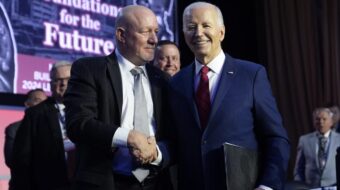
HARRISBURG, Pa. – Management giveback demands, contained in a “last, best and final” contract offer which its bargainers then refused to discuss, forced exploited and low-paid professors at 14 Pennsylvania state colleges to strike, starting at 6 a.m. on Oct. 19.
“At 11:35 pm, we made a last attempt to negotiate through back channels,” said Dr. Kenneth Nash, president of the independent union, the Association of Pennsylvania State College and University Faculties, which represents the 5,500 faculty members and coaches at the 14 state schools.
“We are headed to the picket lines, but even on the picket lines, our phones will be on, should the State System decide it doesn’t want to abandon its students. They’ll know where to find me at 5:30 am. I’ll be outside the chancellor’s office at the Dixon Center on the picket line.”
The forced strike left the 107,000 students at the 14 schools – universities such as Cheyney State and Shippensburg State – with empty classrooms. At several, including Clarion University and Slippery Rock State, the students headed for the picket lines to join their professors. The professors have been toiling without a contract since June 30, 2015.
The 25-page “last, best and final” offer from the state system’s management featured:
- Increases in pay inequity, by putting adjunct faculty members, 60 percent of whom are women, on a separate and lower salary scale. The system also offered bigger raises to higher-ranking – tenured—faculty, and smaller ones to lower-ranked professors, Mash said.
- Cuts in funding for professional development, along with a 67 percent increase in the number of interns faculty would have to supervise, with no additional pay for doing so.
- Changes in tenure protections and promotion processes, removal of grievance rights in some cases and management latitude to retrench, making it harder for fired faculty to find new jobs.
Mash said the union agreed to “dramatic reductions in our healthcare coverage and accepted proposals to shift millions of dollars in healthcare costs to our members by accepting deductibles, increased copays for prescriptions and other givebacks. But these concessions weren’t enough for the State System and (chancellor) Frank Brogan.” The union also offered a smaller wage package than other state employees received.
Gov. Tom Wolf (D) tried to keep both sides at the bargaining table until an agreement was reached. He was unsuccessful, as management walked out.
“We must ensure our professors are treated fairly while recognizing” the state college system’s “difficult financial situation due to years of underfunding. There is enough common ground for the two sides to reach a final compromise…A strike could drive a loss of students, which would further exacerbate an already precarious financial situation for the state system. We have to look no further than what happened to Temple University following the faculty strike in 1990. It took years for Temple to recover its student population,” Wolf added.












Comments